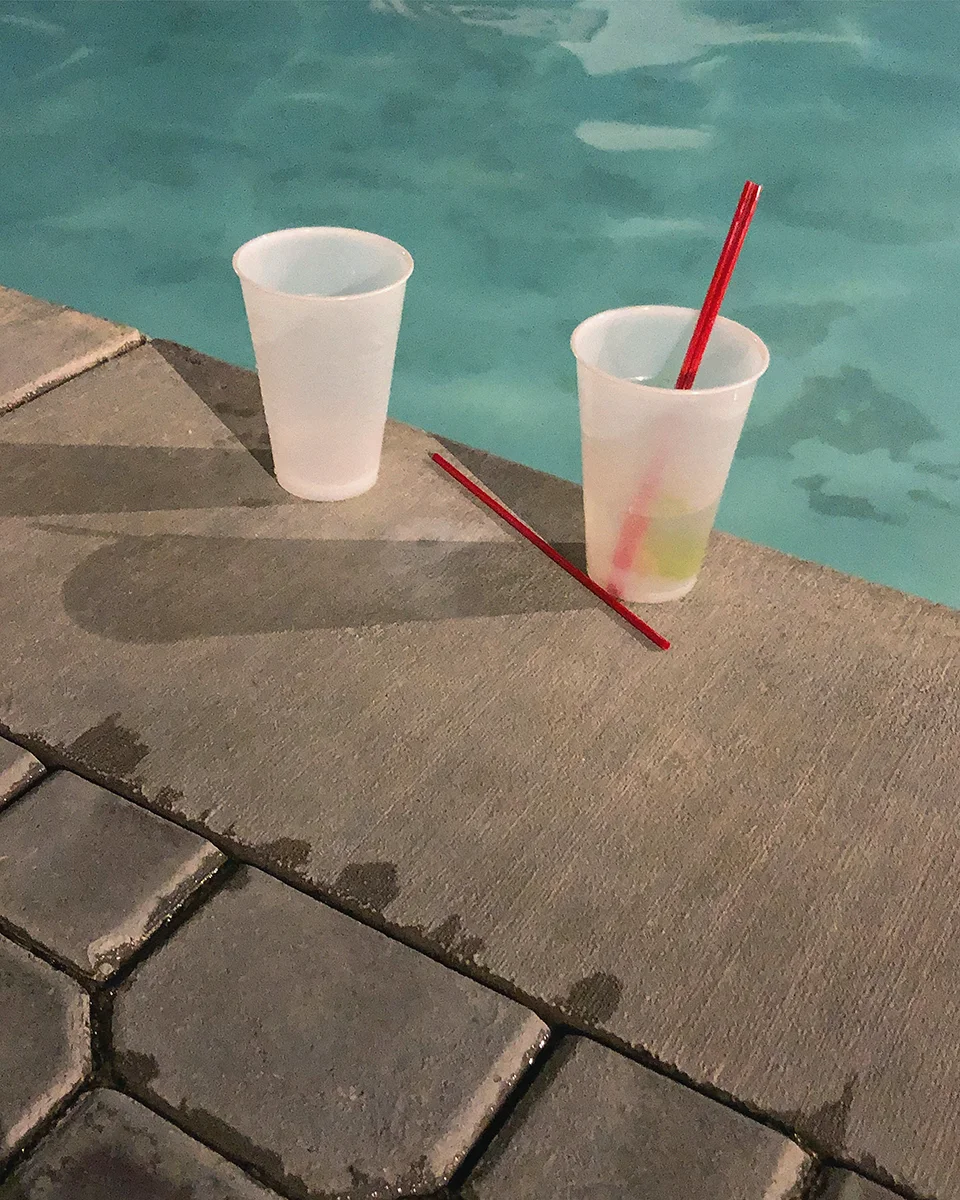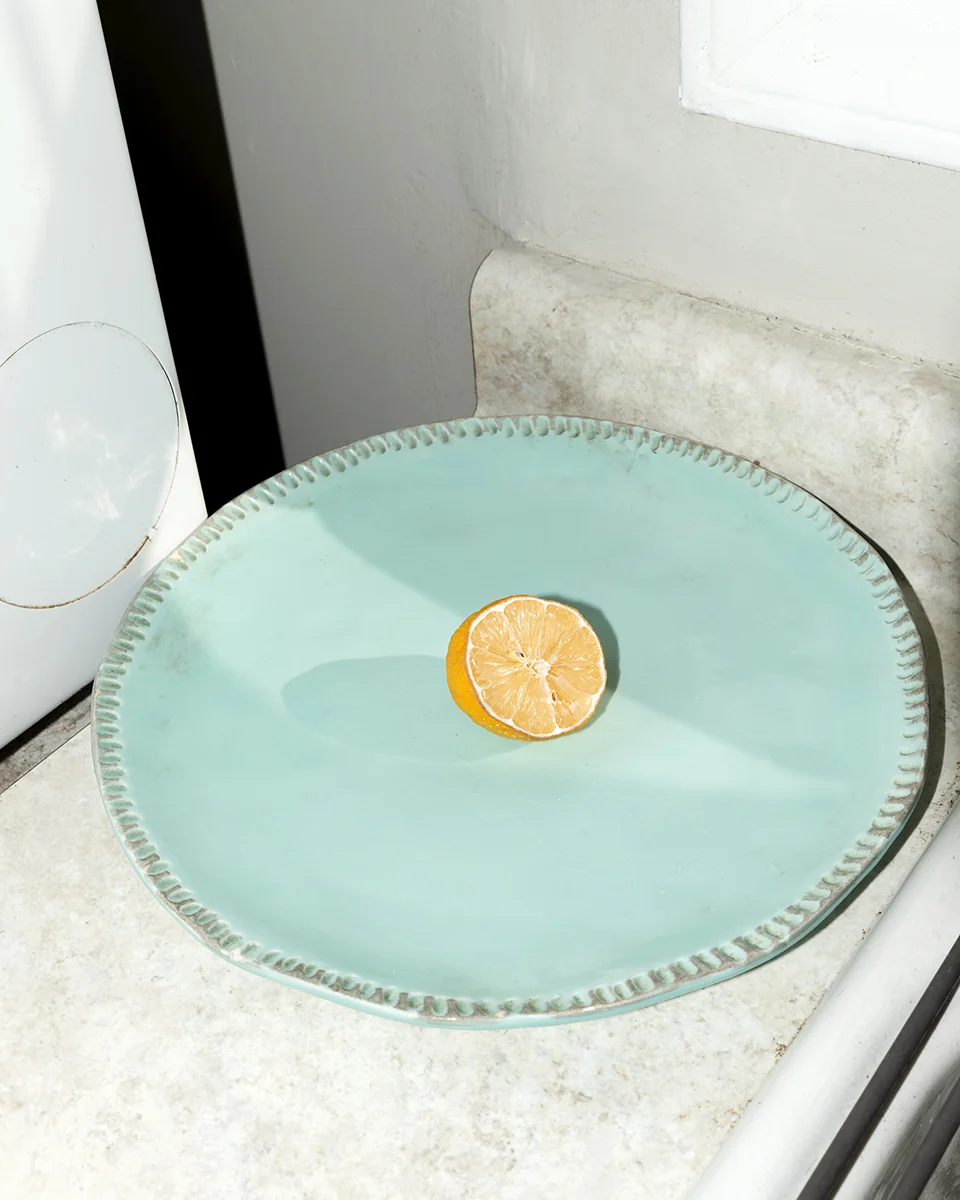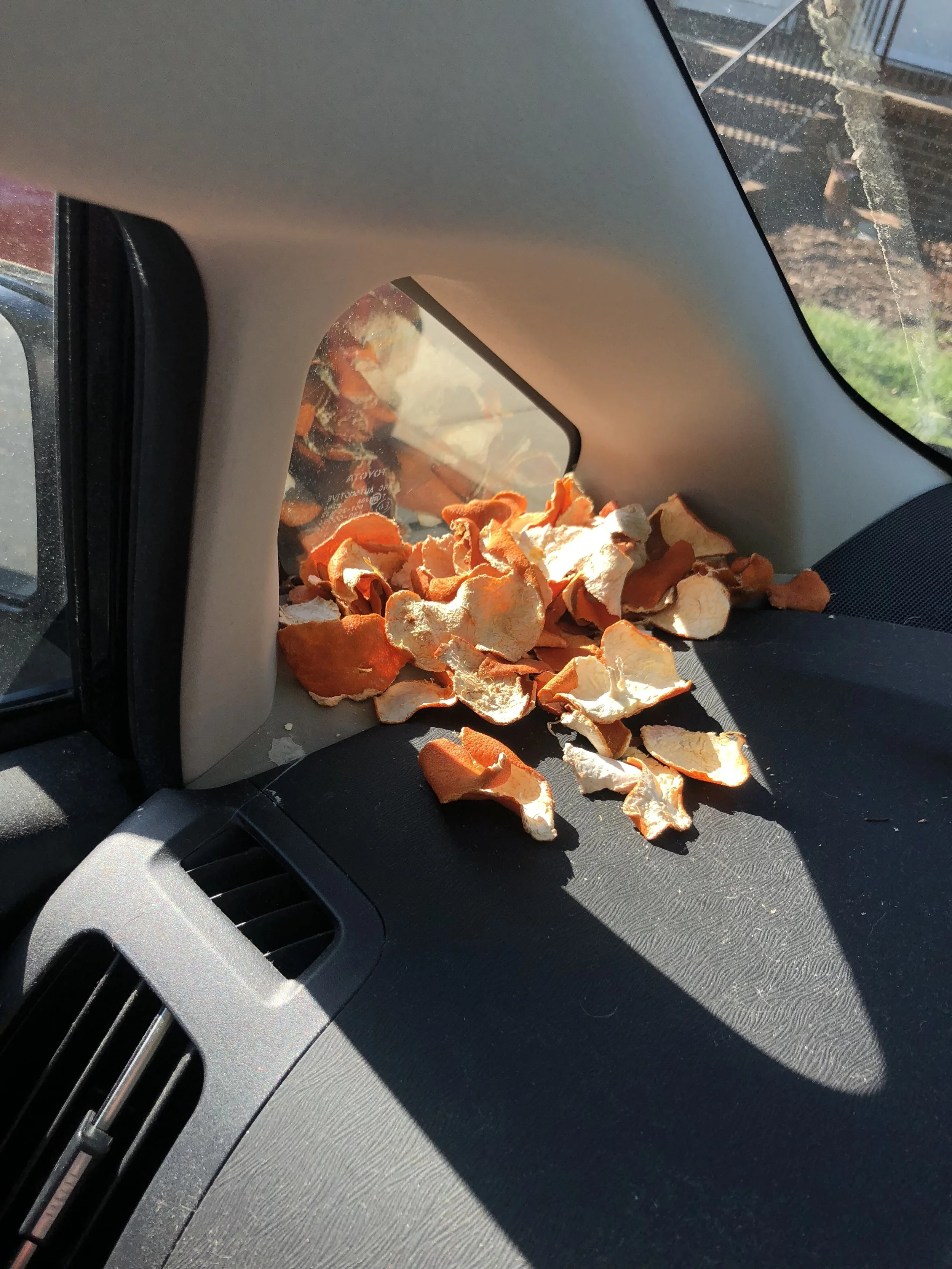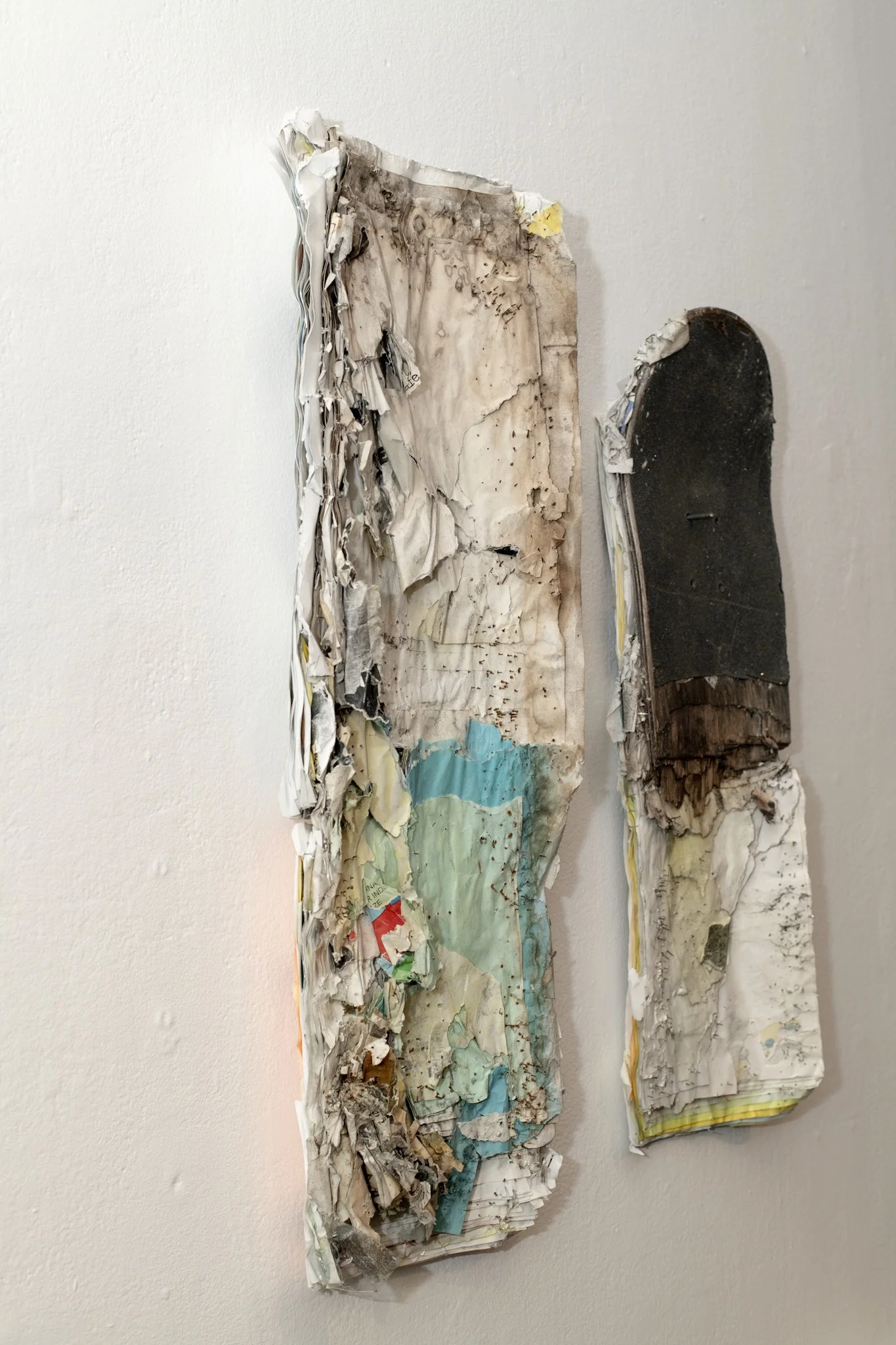© Lindsay Metivier
Lindsay Metivier finds soul in fleeting moments.
For the past few years, North Carolina-by-way-of-Boston-based Metivier has gathered her often random-seeming photos into an archive of quiet musings. On the surface, they might appear unrelated, but there’s a strange specificity to her chaotic eye.
Cheap drinks in clear plastic cups beside a chlorine-green swimming pool. An obtuse circular imprint in a concrete slab. A blue paper card that reads “crisis” – found, or intentionally placed on a patch of grass (it’s unclear, and that’s fine.) A barrage of sometimes fresh, sometimes moldy sun-soaked oranges and orange peels obsessively collected and sent to the artist from friends near and far. These pictures gather details from daily life and celebrate the charge below their arbitrary surface.
Following her thesis exhibition earlier this year, I reached out to learn what brings her work together.
Jon Feinstein in conversation with Lindsay Metivier
˙© Lindsay Metivier
Jon Feinstein: Your work is organized into distinct projects on your website, but there's a real fluidity to all of them, and I think in some cases, images appear in multiple projects could be remixed or live anywhere.
Lindsay Metivier: The categories are a little arbitrary in this sense - it is all one project, as far as overarching themes go - but I think they’re helpful to me and to the viewer by providing guideposts for navigation through something that would otherwise be unwieldy or overwhelming.
It’s similar to how musical genres don’t necessarily reflect the way people listen to music, but are helpful, at their most banal, allowing people to make sense of abundance, giving them something to push off from. And yes, there is a repetition of subjects, places, my dog, and objects consistent throughout my work, but the permutations and arrangements are intended to result in the possibility of different narratives.
My hope is that the monotony of everyday will become transformed into something lively, worthy of contemplation, and full of possibilities. An absurd image might become a celebration of the potential to subvert the banality of ordinary life. I want some of the work to elicit smiles before a the viewer feels an undertow of sadness or melancholy pulling at them simultaneously.
Feinstein: The one less arbitrary, more distinct marker within all these weaving chapters is oranges.
Metivier: The orange peels are photographic to me, a bit like photo negatives. They imply the presence or essence of something that’s no longer there. I’ve been working on a sculpture series consisting of layers of show fliers, calcified by time, stripped from lamp poles, that hold their form, and it’s a similar impulse. You’re foregrounding something by drawing attention to it’s absence.
It also has to do with tracing the passage of time. You typically see fruit in still-lives, fresh and ripe in the bowl, but the peels that I collect are aged by moisture and air, bleached by sunlight - they’re almost cameraless photographs, themselves, and documenting them has taken on a life of its own. People send me peels and photographs of peels; whatever people see in the project, it seems to strike a chord.
© Lindsay Metivier
© Lindsay Metivier
© Lindsay Metivier
Feinstein: You've also been working with sculpture. Where does this fit into your photography?
Metivier: It’s been coming together for a while, but it’s only recently that I’ve felt comfortable sharing the work, publicly. On one hand, there’s a hesitation to step away from specialization, especially having just finished grad school - because that’s part of what grad school is about, right?
Narrowing your focus and shoring up your credentials in a particular area. But on the other, it’s a lot of the same themes, and a lot of the same methodology. It’s all accumulation - the accretion of layers, images, textures, moments and memories. The more it felt like one, larger project, explored at different angles, the more comfortable I felt putting everything out there, at once, for people to consider and make sense of.
© Lindsay Metivier
© Lindsay Metivier
Feinstein: In the press release for your recent thesis show, you're described as a "compulsive collector of things…"
Metivier: Both my compulsion to archive and the subject matter of my photographs are heavily influenced by my upbringing. I grew up the daughter of a garbage man and the granddaughter of a hoarder who wore lipstick on her cheeks and owned an antiques store called Trash and Treasures.
Every day my father came home with a truck full of treasures we’d wear, keep, or sell at our summer yard sales. Winter weekends were spent filling grocery bags of clothing and tchotchkes for dollars at church sales. This made me value the beauty and constancy in unusual things, the discarded, and the overlooked. Some joke that I make photographs the way I collect objects (orange peels, glass insulators, old pennies and synthesizers to name a few).
© Lindsay Metivier
Feinstein: What was behind the title "Almost No Memory?"
Metivier: I have a self-deprecating sense of humor. There’s a running joke with my friends about how many tabs I have open in my browser at any given time, how many items are on my desktop, and how many hard drives I’ve filled up. It’s this contradiction, where the more memories you accrue, the less overall memory you have to spare, the less space for new experiences to fit in, or at least that’s the fear, rational or not. Part of my work is arranging the already existing memories and their echoes or multiples into formations that feel meaningful - bigger pictures, made up of smaller ones.
Below are quotes from the Lydia Davis short story collection “Almost No Memory”, which was the direct inspiration for my title. Lydia Davis is an American writer noted for literary works of extreme brevity.
“Or she wanted to make a note because to make a note was her way of thinking this thought.”
“...or if she remembered, then did not know whether she was thinking it now or whether she had only once thought it, or understand why she had had a thought once and then years later the same thought, or a thought once and then never the same thought again.”
© Lindsay Metivier
© Lindsay Metivier
Feinstein: Did going through University of North Carolina’s MFA program change how you think about making work?
Metivier: It feels a little too early to tell. Honestly, I think that moving to another part of the country, and having new things to photograph, new input, has been just as important. Grad school was great from the standpoint of giving myself permission to focus on photography full-time, or close to it.
Feinstein: What about your relocation from Boston to North Carolina?
I think it’s also been healthy to step away from the Northeast, where even though I was in Boston, there was that New York mindset of the art world being at the center of the universe. Here in North Carolina, it’s less separate, more grounded, socially intertwined with a lot of other things, and that resonates with my interests and impulses.
So much of my work is observation. If you change the environment - settings, personalities, conditions - the work is going to reflect that. To record the mundane and invest it with significance, you have to immerse yourself in it, spend time at bars, clubs, markets, etc, and start to notice things at the periphery that are commonly overlooked. The work is weirdly diaristic in that the images are as much a product of my frame of mind on any given day as they are of light conditions and outside forces - the object stays the same, but I change, and you see that in these multiples - theme and variation as a barometer of emotional weather.
© Lindsay Metivier
© Lindsay Metivier
© Lindsay Metivier














